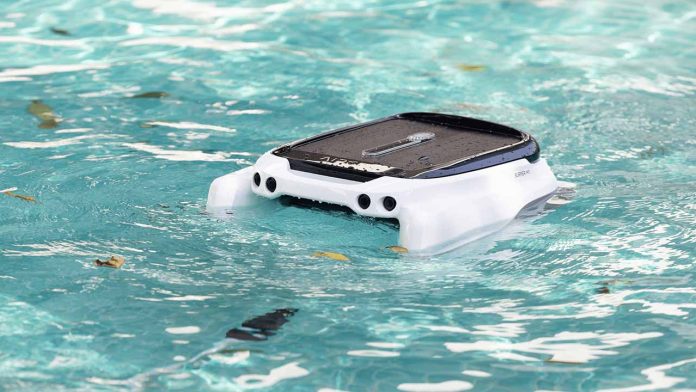A robotic pool cleaner can offer a convenient way to maintain a sparkling pool, but the effectiveness of these devices can be significantly influenced by the pool’s design. Pool shape and the presence of obstacles play a crucial role in determining a cleaner’s coverage and overall performance. This article delves into how different pool designs affect cleaning and offers strategies for maximizing coverage in challenging pools.
How Different Pool Shapes Challenge Robotic Cleaners
While rectangular and oval pools provide straightforward navigation for robotic cleaners, more complex shapes introduce unique challenges:
- Freeform Pools: These pools, characterized by irregular curves and organic shapes, can be difficult for some cleaners to navigate. The lack of straight lines and predictable paths can confuse the cleaner’s navigation algorithms, leading to incomplete coverage or getting stuck. Cleaners with advanced navigation systems, such as those using gyroscopes, sensors, or mapping technology, are better suited for these shapes.
- Kidney-Shaped Pools: The concave curves of kidney-shaped pools can create dead zones where some cleaners struggle to reach. The cleaner may repeatedly navigate the larger sections of the pool but miss the tighter curves. Look for cleaners with good maneuverability and the ability to turn sharply.
- L-Shaped Pools: The sharp corners of L-shaped pools can also be problematic. Cleaners may struggle to make the 90-degree turn, leaving debris accumulated in the corner. Cleaners with powerful drive systems and the ability to climb walls can often overcome this challenge.
- Pools with Coves or Alcoves: These recessed areas can be difficult for cleaners to access, especially if they are narrow or deep. Cleaners with smaller footprints and agile movements are more likely to navigate these areas effectively.
The Impact of Obstacles
Obstacles within the pool further complicate the cleaning process:
- Steps and Ladders: These vertical structures can obstruct a cleaner’s path and prevent it from reaching certain areas. Cleaners with good wall-climbing abilities can often navigate steps, but some may struggle with ladders.
- Benches and Seating Areas: These submerged features can create dead zones beneath them, where the cleaner cannot reach. Look for cleaners with low profiles or the ability to navigate around these obstacles.
- Main Drains and Skimmer Intakes: These openings can sometimes trap a cleaner or interfere with its movement. Cleaners with intelligent navigation systems are often designed to avoid these areas.
- Tight Corners and Narrow Passages: These areas can be difficult for larger cleaners to maneuver. Smaller, more agile cleaners are better suited for pools with these features.
Choosing a Cleaner Designed for Complex Pool Designs
When selecting the best pool cleaner for a pool with a complex design, consider the following features:
- Advanced Navigation Systems: Cleaners with gyroscopes, sensors, or mapping technology can navigate complex shapes more efficiently and ensure complete coverage.
- Wall Climbing Capability: This is essential for cleaning walls, steps, and other vertical surfaces. Look for cleaners with powerful motors and good traction.
- Agile Movement and Maneuverability: Cleaners that can turn sharply and navigate tight spaces are better suited for pools with curves, corners, and other obstacles.
- Cable Length and Management: Ensure the cable is long enough to reach all areas of the pool, and look for features like swivel cables or tangle-free technology to prevent tangling.
- Cleaner Size and Profile: A smaller cleaner with a low profile is more likely to navigate tight spaces and under benches.
Strategies for Maximizing Coverage in Challenging Pools
Even with a well-suited cleaner, some strategies can further maximize coverage in challenging pools:
- Manual Pre-Cleaning: Before deploying the cleaner, manually brush any heavy debris or algae buildup from hard-to-reach areas.
- Strategic Placement: When placing the cleaner in the pool, try to position it in a central location or in an area that is particularly prone to debris accumulation.
- Multiple Cleaning Cycles: Running the cleaner for multiple shorter cycles can sometimes provide better coverage than a single long cycle, especially in complex pools.
- Cable Management: Carefully unwind the cable and avoid creating loops or knots. Consider using a cable caddy or other cable management solutions.
- Regular Maintenance: Keep the cleaner’s filters, brushes, and tracks clean and in good condition to maintain optimal performance.
- Observe the Cleaner’s Behavior: Pay attention to how the cleaner navigates your pool. If it consistently misses certain areas, try adjusting its starting position or cleaning cycle settings.
Conclusion
Pool shape and obstacles significantly impact robotic cleaner coverage. By understanding these challenges and choosing a cleaner with appropriate features, you can ensure efficient and comprehensive cleaning, even in complex pool designs. Implementing the strategies outlined above can further maximize coverage and keep your pool sparkling clean with minimal effort.








